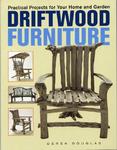 -Content Inspired by the book “Driftwood Furniture”. The book was written by Derek Douglas.
-Content Inspired by the book “Driftwood Furniture”. The book was written by Derek Douglas.
This is a hobby that can be enjoyed with a varied list of tools, depending on your physical strength, age, stamina and pocketbook. For example, a jigsaw and handsaw could be used instead of a band saw, but the physical effort is much more strenuous. Try it for a day. I’m sure you will agree.
Cutting Tools
As it happens when you’re working with natural or found materials, they likely wont be the right shape or length that you need, so you’ll have to cut them to size. You may also have to make some notches. The following tools are common to be used.
Portable Band saw – This sits on your workbench and can be clamped in place. A 3/8-inch blade might be a good size because a 1/4-inch tends to wander too much.
Handsaw – You want a saw with sharp teeth. Something that will slice through an 8-inch log in minutes. Keep your fingers out of the way of this one.
Jigsaw – This is a really handy tool for notches that are sometimes very difficult to do with a band saw.
Drilling tools
To make solid joints, you’re going to be connecting 99 percent of your pieces together with screws and lag bolts, and pre drilling everything. I recommend having two different drills. And get a good quality drill; Something with power. Both the drills should be variable-speed types, one for drilling holes and the other for screwing (Robertson or Phillips bit). Its always helpful to have a good set of drill bits – up to 3/8 inch.
Sanding and shaping tools
You’ll need these for finishing work since you wont want to get caught, scraped or snagged on any of the furniture you’re building. The following is what is common to use, though you don’t need them all for the work you’ll be doing.
End sander – This is a tremendous labor saving device. 60-grit is recommended, but other grits are available.
Sanding drum – What you’re looking for is the type that can occasionally fit in you’re drill. The diameter should be 2 to 3 inches so you can occasionally use it to make some notches instead of using your jigsaw or band saw. Use whichever is easiest for the task at hand.
Dremel Drill – Used for shaping a gripping handle or a wheelbarrows, using a 1 1/4 inch mushroom compound curve attachment from Dura-Grit. You could also use a round-shaped Micro Plane.
Belt Sander – This is a handheld sander. It is not an essential item, but if you have one already it is useful for leveling the seat and back pieces that cause discomfort.


Dear Mike,
I’d like to make some sculptures out of driftwood I’ve collected.
1. Many of the pieces have bugs that are eating the interior. I don’t want to use bleach because I want to keep the color of the wood and various fragile finishes intact.
2. How can I invisibly join the pieces without glue?
Any advice you can offer will be greatly appreciated. I’m moving in a few days and would like to complete these projects beforehand.
Thank you for your help,
Barbara Egan
What I have done once is use a mortis and tenon joint to join two pieces together. Drill a hole (x) wide and then use a tenon cutter to cut a piece of wood to fit in the hole.
Please do not post with my phone number!
ok